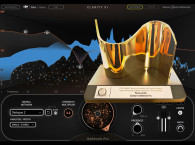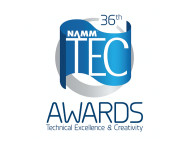Founded in 2004 by George Petersen, Editor of FOH magazine, and presented since 2015 by the NAMM Museum of Making Music, the TECnology Hall of Fame Inductees are selected by a panel of more than 50 recognized audio experts, including authors, educators, engineers and other professionals. Products or innovations must be at least 10 years old to be considered for induction.
This year, there are only five entries, but all are extremely worthy of note. These are the 2021 NAMM TECnology Hall of Fame inductees, listed chronologically:

1938 - Western Electric 639A Ribbon Microphone
Introduced in 1938, the Western Electric 639A was a multipattern microphone design that offered switch-selectable pickup patterns. Nicknamed the “birdcage” microphone, under its large protective shell and windscreen were two separate mic capsules — dynamic and ribbon. Selecting the dynamic element alone yielded an onmidirectional response; the ribbon capsule offered a figure-8 pattern; and equally combining the output of the two resulted in a directional (yet wide 120°) cardioid response.
With its flexibility and a (then) wide 40 Hz to 10k Hz frequency response, the microphone was quickly adopted by broadcast, recording and P.A. users and remained in production for years. A later 639B variant featured a choice of six directivity patterns, and beginning in 1941, both the 639A and 639B models were sold and marketed under the Altec brand.

1957 - RCA Mark II Sound Synthesizer
Today, we are so used to pocket-sized electronics that it’s hard to imagine technologies like the first computer — 1951’s UNIVAC 1, which used 5,000 vacuum tubes and weighed more than eight tons. Another such example is 1957’s RCA Mark II Sound Synthesizer, which was the first programmable electronic synthesizer and sequencer and filled an entire room floor to ceiling with rackmount components. Funded by a Rockefeller Foundation grant and installed at Columbia University, the system was designed by RCA researchers Herbert Belar and Harry F. Olson — the latter being well-known for his countless audio contributions, including RCA’s famed ribbon microphones.
With 4-note polyphony, a primitive sequencer and a need for constant maintenance, the Mark II was hardly a game changer, but it paved the way for a revolution in computer music in the years to come. The system is still mostly intact and today resides at Columbia University’s Computer Music Center facility in New York City.

1968 - 3M M56 16-Track Recorder
The multitrack recording revolution began to pick up steam in the mid-1960’s, as musicians and studios sought to keep up with the latest technology. In the 1950’s, Ampex made a few custom 8-track machines (mostly notably for Les Paul and Atlantic Studios), but wide access to such tools didn’t happen until at least a decade later. In 1967, Ampex created a custom 16-track for Mirasound Studios in NYC, and debuted the first commercially available 2-inch 16-track machine (based on its MM-1100 transport) in 1968.
Best known in audio circles as a tape manufacturer, the 3M company had launched the M23, the first commercially available 8-track in 1966 and had assembled a team of audio pros (Dale Manquen, Don Kahn, Jack Mullin and Jim Leatherman) to create its first 16-track. The prototype was unveiled at the New York AES Convention in October 1968, and was well-received, especially for its compact form factor — only 30-inches wide, about half the size of the competing Ampex recorder — which allowed it to be easily wheeled between different rooms in a multi-studio complex. That prototype eventually became the popular M56, and not only featured an advanced Isoloop audio tape transport that was gentle on tape, but contained its electronics on 64 circuit cards for easy servicing. Even today, more than 50 year later, many recording engineers still consider the M56 to be among the best-sounding multitrack recorders ever made.

1975 - Don Keele Constant Directivity Horn
A leading authority on loudspeaker technology, D.B. “Don” Keele has done it all, from his dozens of published technical AES papers, to his design work for leading manufacturers — among them Electro-Voice, JBL and Klipsch — an AES board member and even as a journalist, reviewing loudspeakers for Audio magazine. Products he’s contributed to are familiar names to audio pros, such as his work on JBL’s famed Bi-Radial horn series and programming for Crown Techron’s TEF systems.
As a senior designer with Electro-Voice, he conceived and patented the Constant Directivity (CD) loudspeaker horn in 1975. In addressing the issue of beamwidth varying at different frequencies, Keele’s CD horn design employed a hybrid horn with an exponential expansion rate near the throat followed by a conical expansion section and ending with a rapidly flaring flange at the mouth. Even today, some 45 years later, his landmark patent remains a standard design concept throughout the professional loudspeaker industry. In fact, in 2002, Keele was honored with a Scientific and Engineering Academy Award from the Academy of Motion Picture Arts and Sciences for work on Constant Directivity loudspeakers for cinema applications.

1977 - Ed Long Near Field Monitoring
Today, the concept of Near Field Monitoring seems like an industry standard, but we have Edward M. Long to thank for that. One of the most influential loudspeaker designers of the 20th century, Long was noted for co-inventing (and trademarking) the Time-Align speaker process and the pressure zone technology made popular in Crown’s PZM microphones, as well as developing and selling the first Near Field Monitor (another Ed Long trademark). In 1977, Long’s Calibration Standard Instruments (CSI) debuted the MDM-4 (Mix-Down Monitor-4), a compact studio monitor that employed his Time-Align concept, but also introduced the notion of the Near Field Monitor (another Long trademark), which — by placing the speakers close to the listener — largely negated the effects of the room acoustics. This technique caught on and today remains a standard method used in nearly every recording facility throughout the world and almost every recording made in the past four-plus decades.
Ed Long retired in 2003 and turned his energy to writing both technical (Time Align Design and More) and illustrated childrens' adventure books, including Magellan's Gold and Monarch of the Andes. He resided in San Jose, CA until his death on December 17th, 2016.
www.tecawards.org/tecnology-hall-of-fame






